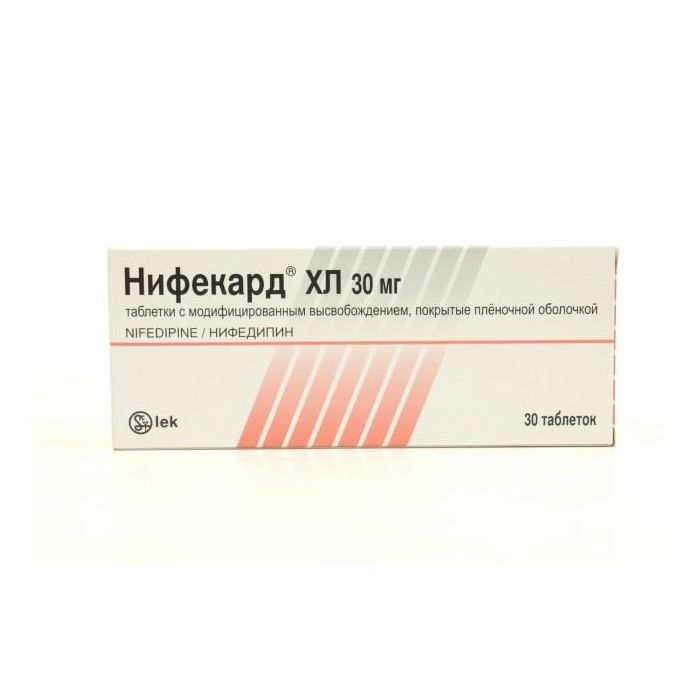nifedipine | Nifecard CL tablets with mod.vysv.pokryt.plen.ob. 30 mg 30 pcs.
Special Price
$32
Regular Price
$39
In stock
SKU
BID463277
release form
Controlled Release Tablets.
Packing
30 pcs
Pharmacological action of
Nifecard CL - selective BMCC, a derivative of 1,4-dihydropyridine. It has a vasodilating, antianginal and hypotensive effect. It reduces the flow of Ca 2+ to cardiomyocytes and smooth muscle cells of the coronary and peripheral arteries in high doses inhibits the release of Ca 2+ from intracellular depots. Reduces the number of functioning channels without affecting the time of their activation, inactivation and recovery.
Dissociates the processes of excitation and contraction in the myocardium mediated by tropomyosin and troponin, and in the smooth muscles of blood vessels mediated by calmodulin. In therapeutic doses, it normalizes the transmembrane current of Ca 2+, impaired in a number of pathological conditions, primarily in arterial hypertension. Does not affect the tone of the veins. It enhances coronary blood flow, improves blood supply to the ischemic zones of the myocardium without the development of the “robbing" phenomenon, and activates the functioning of collaterals. Expanding peripheral arteries, reduces OPSS, myocardial tone, afterload, myocardial oxygen demand and increases the duration of diastolic relaxation of the left ventricle. Virtually no effect on SA and AV nodes and does not have antiarrhythmic activity. Enhances renal blood flow, causes moderate natriuresis.
Indications
Arterial hypertension, IHD: stable angina pectoris, vasospastic angina pectoris.
Contraindications
Arterial hypotension, severe aortic valve stenosis, obstructive cardiomyopathy, pregnancy and lactation, hypersensitivity to nifedipine.
Use during pregnancy and lactation
Contraindicated.
Composition
Each tablet contains 30 mg of nifedipine.
Dosage and administration of
Nifecard XL is prescribed individually. The initial dose of the drug is 30 or 60 mg per day once. Tablets should be taken without chewing, you can not crush them or divide.
Dose selection is carried out gradually, at intervals of 7-14 days.
The maximum daily dose is 90 mg.
With the necessary withdrawal of the drug, the dosage is gradually reduced until it is completely withdrawn.
Side effects of the
From the cardiovascular system: manifestations of excessive vasodilation (asymptomatic decrease in blood pressure, sensation of flushing of the face, flushing of the face, fever), tachycardia, palpitations, arrhythmia, peripheral edema, rare chest pain Blood pressure, syncope, syncope in some patients, especially at the beginning of treatment, angina attacks may occur, which requires discontinuation of the drug. Isolated cases of myocardial infarction are described.
From the side of the central nervous system: headache, dizziness, fatigue, weakness, drowsiness with prolonged use at high doses - limb paresthesia, depression, anxiety, extrapyramidal (parkinsonian) disorders (ataxia, masked face, shuffling gait, stiffness of the movements of the arms and legs, tremors of the hands and fingers, difficulty swallowing).
From the side of the organ of vision: very rarely - visual impairment (including transient blindness with a maximum concentration of nifedipine in blood plasma).
From the digestive system: dry mouth, decreased appetite, dyspepsia (nausea, diarrhea or constipation) rarely - gum hyperplasia (bleeding, soreness, swelling) with prolonged use - impaired liver function (intrahepatic cholestasis, increased activity of hepatic transaminases).
From the hemopoietic organs: anemia, asymptomatic agranulocytosis, thrombocytopenia, thrombocytopenic purpura, leukopenia.
From the musculoskeletal system: arthritis rarely - arthralgia, swelling of the joints, myalgia, cramps of the upper and lower extremities.
From the urinary system: increased daily urine output, impaired renal function (in patients with renal failure).
From the respiratory system: rarely - difficulty breathing, cough very rarely - pulmonary edema, bronchospasm.
From the endocrine system: very rarely - gynecomastia (in elderly patients, completely disappearing after drug withdrawal), hyperglycemia, galactorrhea, weight gain.
Allergic reactions: rarely - itchy skin, exanthema, exfoliative dermatitis, photodermatitis very rarely - autoimmune hepatitis.
Drug Interaction
Due to synergistic action, caution should be exercised when nifedipine and other antihypertensive agents, beta-blockers, and nitrates are used concomitantly. Concomitant administration of nifedipine and digoxin increases plasma concentrations of nifedipine, therefore, monitoring of plasma digoxin concentrations and, if necessary, adjustment of digoxin dose are required. Nifedipine lowers the metabolism of phenytoin, whereas concomitant administration of nifedipine with cyclosporine or cimetidine may cause an increase in nifedipine blood levels. Concomitant administration of nifedipine and fentanyl may cause severe hypotension, so it is recommended that nifedipine be discontinued at least 36 hours before anesthesia (if possible). Plasma concentrations of quinidine may be reduced by 50% in patients receiving nifedipine. Nifedipine causes an increase in blood levels of theophylline while being administered.
Overdose
Overdose with nifedipine causes peripheral vasodilation with pronounced and possibly prolonged systemic hypotension.
Treatment of overdose consists in removal of a preparation from an organism and careful control of vital functions, activity of heart, lungs and excretory system. Nifedipine clearance is increased in patients with impaired liver function. Due to the high degree of binding to plasma proteins, hemodialysis is not effective.
Storage conditions
Store at a temperature not exceeding 25 C.
Expiration
2 years.
Active ingredient
Nifedipine
pharmacy leave terms
Dosage form
Dosage form
tablets prolong.
Submit your review to Earn 10 Reward Points click here to login
Write Your Own Review

